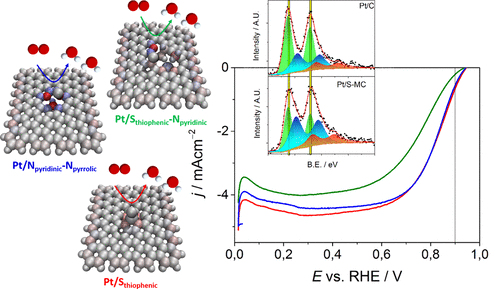当前位置:
X-MOL 学术
›
ACS Catal.
›
论文详情
Our official English website, www.x-mol.net, welcomes your
feedback! (Note: you will need to create a separate account there.)
Density Functional Theory (DFT) and Experimental Evidences of Metal–Support Interaction in Platinum Nanoparticles Supported on Nitrogen- and Sulfur-Doped Mesoporous Carbons: Synthesis, Activity, and Stability
ACS Catalysis ( IF 11.3 ) Pub Date : 2018-01-11 00:00:00 , DOI: 10.1021/acscatal.7b03942 Valentina Perazzolo 1 , Riccardo Brandiele 1 , Christian Durante 1 , Mirco Zerbetto 1 , Valerio Causin 1 , Gian Andrea Rizzi 1 , Isotta Cerri 2 , Gaetano Granozzi 1 , Armando Gennaro 1
ACS Catalysis ( IF 11.3 ) Pub Date : 2018-01-11 00:00:00 , DOI: 10.1021/acscatal.7b03942 Valentina Perazzolo 1 , Riccardo Brandiele 1 , Christian Durante 1 , Mirco Zerbetto 1 , Valerio Causin 1 , Gian Andrea Rizzi 1 , Isotta Cerri 2 , Gaetano Granozzi 1 , Armando Gennaro 1
Affiliation

|
In this paper, we report a comprehensive investigation of Pt nanoparticles (NPs) deposition on nitrogen- and sulfur-doped or codoped mesoporous carbons (N-MC, S-MC, and N,S-MC) to develop active and durable oxygen reduction catalysts for fuel cells. N-MC, S-MC, and N,S-MC were prepared by employing mesoporous silica as hard template and suitable organic precursors. Pt NPs were deposited by solid-state reduction of platinum acetylacetonate under N2/H2 flow on the three different supports. Pt NPs resulted to be well-dispersed over the doped MC supports with size distributions (from 1.8 nm to 3.5 nm) that are dependent on the type of doping heteroatom (N, S, or N and S). The influence of nitrogen and/or sulfur incorporated into the carbon matrix on the nucleation and growth of Pt NPs was also rationalized based on density functional theory (DFT) simulations. They highlighted that both nitrogen and sulfur increase the interactions between Pt and carbon support, but the interaction decreases as the nitrogen and sulfur functional groups become closer. The effect of sulfur content on the size and activity of Pt NPs was also evaluated. Electrochemical measurements in 0.5 M H2SO4 electrolyte allowed us to investigate the behavior of Pt NPs and to assess the relationship with electrochemical activity and stability. The Pt/S-MC showed mass activity and specific activity comparable with the state-of-the-art commercial standard Pt/C Tanaka (Pt 46% on Vulcan XC72), and the highest catalytic activity, with respect to Pt/N-MC and Pt/N,S-MC, was associated with a stronger interaction between Pt NPs and a thiophenic-like group, as proven by DFT calculations and X-ray photoelectron spectroscopy (XPS) analysis. Pt/S-MC was incorporated in a membrane electrode assembly and tested as cathode material in a PEM fuel cell, while accelerated degradation tests up to 10 000 voltammetric cycles were carried out in 0.5 M H2SO4: the influence of the doped support on the durability of the catalyst under harsh operational conditions has been highlighted.
中文翻译:

密度泛函理论(DFT)和掺杂氮和硫的介孔碳负载的铂纳米颗粒中金属与载体相互作用的实验证据:合成,活性和稳定性
在本文中,我们报告了对氮和硫掺杂或共掺杂介孔碳(N-MC,S-MC和N,S-MC)上Pt纳米颗粒(NPs)沉积的全面研究,以开发出活性持久的氧还原剂燃料电池催化剂。N-MC,S-MC和N,S-MC是通过使用介孔二氧化硅作为硬模板和合适的有机前体制备的。在N 2 / H 2下通过固态还原乙酰丙酮化铂沉积Pt NPs流在三个不同的支撑上。Pt NPs可以很好地分散在掺杂的MC载体上,其尺寸分布(从1.8 nm到3.5 nm)取决于掺杂杂原子的类型(N,S或N和S)。基于密度泛函理论(DFT)模拟,也合理化了掺入碳基质中的氮和/或硫对Pt NPs成核和生长的影响。他们强调说,氮和硫都增加了Pt与碳载体之间的相互作用,但随着氮和硫官能团越来越近,相互作用降低。还评估了硫含量对Pt NPs尺寸和活性的影响。在0.5 MH 2 SO 4中进行电化学测量电解质使我们能够研究Pt NP的行为,并评估与电化学活性和稳定性的关系。Pt / S-MC的质量活性和比活性可与最新的商业标准Pt / C Tanaka相比(在Vulcan XC72上为46%的Pt),并且相对于Pt / N-具有最高的催化活性。 DFT计算和X射线光电子能谱(XPS)分析证明,MC和Pt / N,S-MC与Pt NP与类似噻吩基团之间的较强相互作用有关。Pt / S-MC被并入膜电极组件中,并作为PEM燃料电池中的阴极材料进行了测试,而加速降解测试则在0.5 MH 2 SO 4中进行了高达10000次伏安循环:已经强调了在苛刻的操作条件下掺杂载体对催化剂耐久性的影响。
更新日期:2018-01-11
中文翻译:

密度泛函理论(DFT)和掺杂氮和硫的介孔碳负载的铂纳米颗粒中金属与载体相互作用的实验证据:合成,活性和稳定性
在本文中,我们报告了对氮和硫掺杂或共掺杂介孔碳(N-MC,S-MC和N,S-MC)上Pt纳米颗粒(NPs)沉积的全面研究,以开发出活性持久的氧还原剂燃料电池催化剂。N-MC,S-MC和N,S-MC是通过使用介孔二氧化硅作为硬模板和合适的有机前体制备的。在N 2 / H 2下通过固态还原乙酰丙酮化铂沉积Pt NPs流在三个不同的支撑上。Pt NPs可以很好地分散在掺杂的MC载体上,其尺寸分布(从1.8 nm到3.5 nm)取决于掺杂杂原子的类型(N,S或N和S)。基于密度泛函理论(DFT)模拟,也合理化了掺入碳基质中的氮和/或硫对Pt NPs成核和生长的影响。他们强调说,氮和硫都增加了Pt与碳载体之间的相互作用,但随着氮和硫官能团越来越近,相互作用降低。还评估了硫含量对Pt NPs尺寸和活性的影响。在0.5 MH 2 SO 4中进行电化学测量电解质使我们能够研究Pt NP的行为,并评估与电化学活性和稳定性的关系。Pt / S-MC的质量活性和比活性可与最新的商业标准Pt / C Tanaka相比(在Vulcan XC72上为46%的Pt),并且相对于Pt / N-具有最高的催化活性。 DFT计算和X射线光电子能谱(XPS)分析证明,MC和Pt / N,S-MC与Pt NP与类似噻吩基团之间的较强相互作用有关。Pt / S-MC被并入膜电极组件中,并作为PEM燃料电池中的阴极材料进行了测试,而加速降解测试则在0.5 MH 2 SO 4中进行了高达10000次伏安循环:已经强调了在苛刻的操作条件下掺杂载体对催化剂耐久性的影响。











































 京公网安备 11010802027423号
京公网安备 11010802027423号